In the world of antiques and collectables, condition is usually king. From china and glass to clocks and toys, perfect examples tend to fetch the biggest money. But when it comes to coin collecting, sometimes imperfections can be very valuable indeed.
That’s because the mints that make coins hardly ever make mistakes. And any specimens with errors are usually destroyed before they leave the mint. Survivors are rare – and that makes them interesting and desirable to collectors!
So just how much can they be worth? We’re going to look at the 15 most valuable State quarter errors to find out! And we’ll investigate what to look for to check if your own quarters might be worth a fortune.
Ready? Let’s get started!
Most Valuable State Quarter Errors Worth Money
1. 2005-P Minnesota Quarter PCGS MS67 FS-801 Extra Tree DDR-001 $275
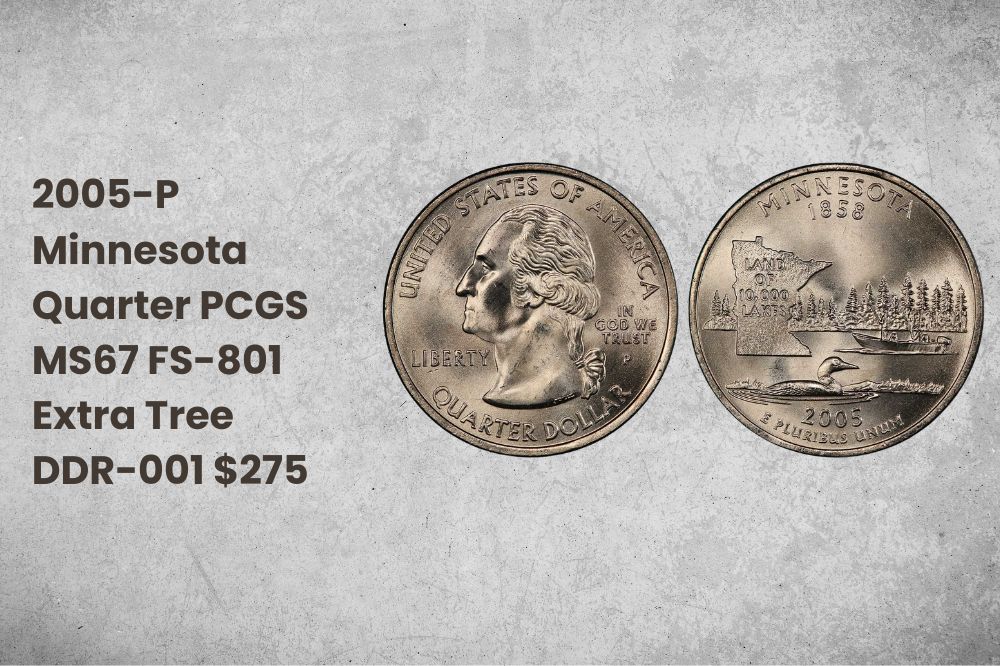
The Minnesota Quarter minted in Philadelphia in 2005 produced lots of error coins. There were more than 50 different varieties that featured a double die on the reverse side.
Different details separated out the different types. But in all cases, the error resulted in the appearance of an extra tree on the reverse.
The most famous variety was given the reference code FS-801 by the independent coin grading authority, the PCGS. It showed a ghostly spruce just to the right of the fourth tree on the right of the state map.
When it was first discovered, collectors became very excited. But it soon became clear that the same error could be found on lots of coins. Well over a thousand extra tree quarters have been unearthed to date. And the PCGS have graded about 200 of the FS-801 variety.
Even so, the best quality coins can still fetch good money. This specimen was graded MS – mint state – 67. (Mint state coins have never been circulated. The numbers go up to 70: the higher the number, the better the condition of the coin.)
While several coins of this standard are known to exist, there are none finer. And today, MS67 specimens realize prices of around $275.
2. 1965 SMS Washington Quarter NGC MS66* Broadstruck $400
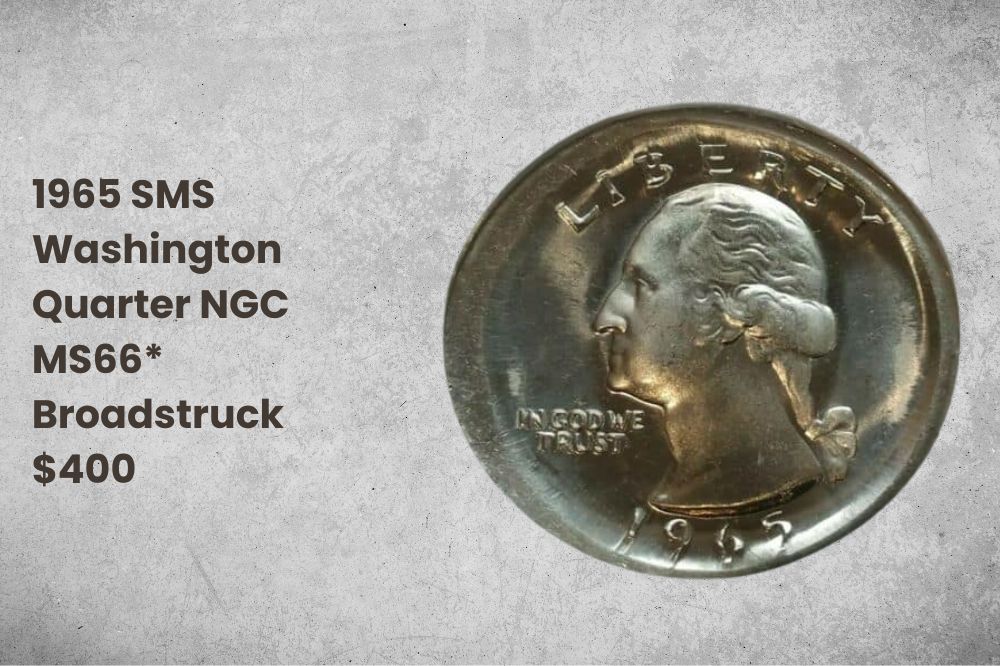
Normally, the hot metal that makes coins is firmly held in place as the coin is struck. That’s done with what’s called a “collar”. But sometimes the collar is lost, allowing the metal to ooze out. The result is a coin with a misshapen rim, making it what’s known as “broadstruck”.
This example was made in 1965 as part of a Special Mint Series. These were made for collectors, and were supposed to be a better quality than standard coins. So finding one with a wobbly rim is pretty rare.
This one was graded by the independent coin grading authority, the Numismatic Guaranty Company, or NGC. They gave it the classification MS 66*. The star indicates it’s higher than 66, but not quite at the standard for 67.
At the time of writing, it’s for sale via an online auction platform for $400.
3. Undated (1999-P) Statehood Quarter ANACS MS65 Double Struck Die Cap $1,265
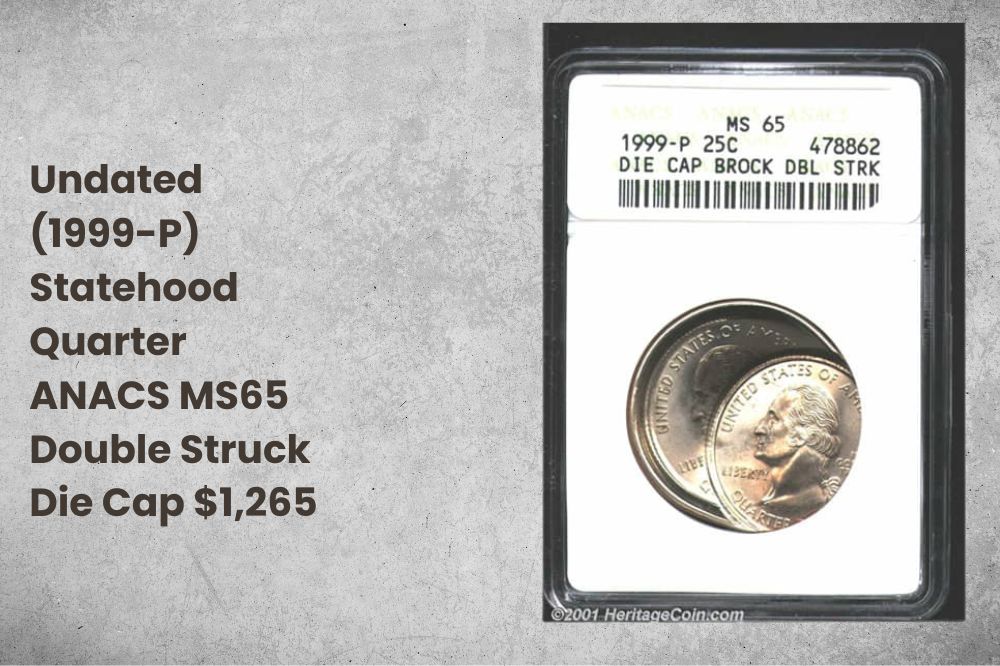
This coin doesn’t have a date, and nor do we know which state it was supposed to commemorate. But it was examined by independent coin graders the ANACS, who believed it to have been minted in Philadelphia in 1999.
When the obverse side of the coin was struck, the die became stuck to the planchet. (The planchet is the metal disc used to make the coin.) It then detached, but was off-center when it was struck again. The result is two separate images on the obverse.
The reverse was struck into the obverse of a previously struck coin. The result is what’s known to coin collectors as “brockage”, and it’s very rare.
This example was graded MS65. It sold at auction in August 2001, making $1,265.
4. 2004-D Wisconsin Quarter PCGS MS66 Extra Leaf High $2,530
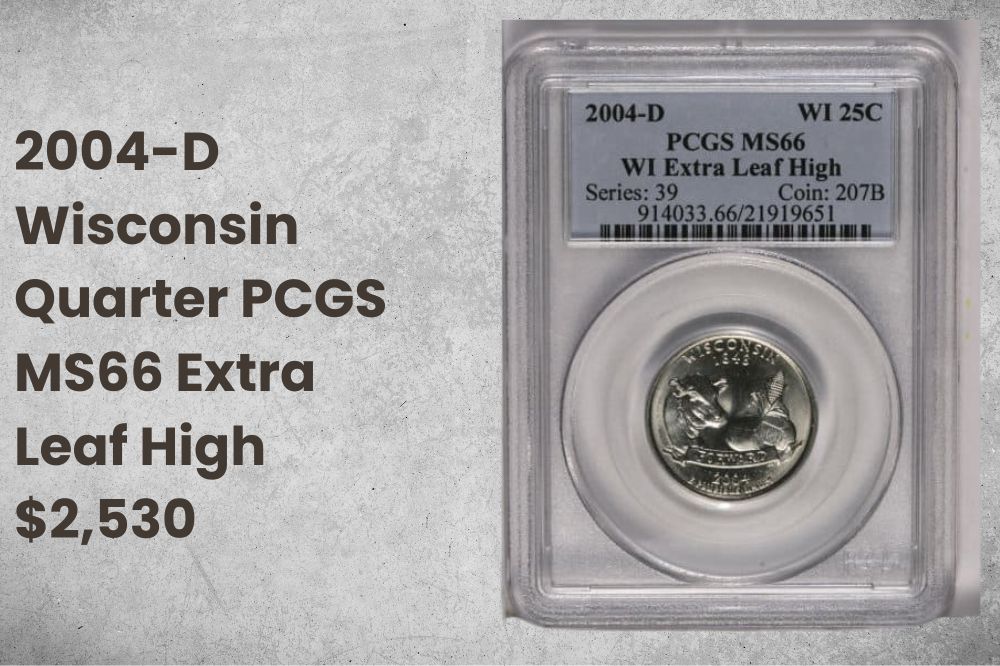
One of the best-known errors can be found in the Wisconsin state quarters minted in Denver. These feature an extra leaf on the husk of corn shown on one side.
It’s not clear whether this was really an accidental addition. Some believe it was formed deliberately by a round-edged tool being pressed into the die.
There are actually two types of extra leaf Wisconsin quarters, with the additional leaf in two different positions. In this case, the extra leaf is shown high up on the corn husk. Collectors know it by the name “extra leaf high”.
The value varies significantly depending on the quality of the coin. This particular specimen was graded MS – mint state – 66 by the PCGS. That means it’s very good quality, with just a handful of minor visible imperfections.
It sold at auction in July 2006 for over $2,500. And that price would be significantly higher today.
5. 2004-D Wisconsin Quarter PCGS MS67 Extra Leaf Low $6,000
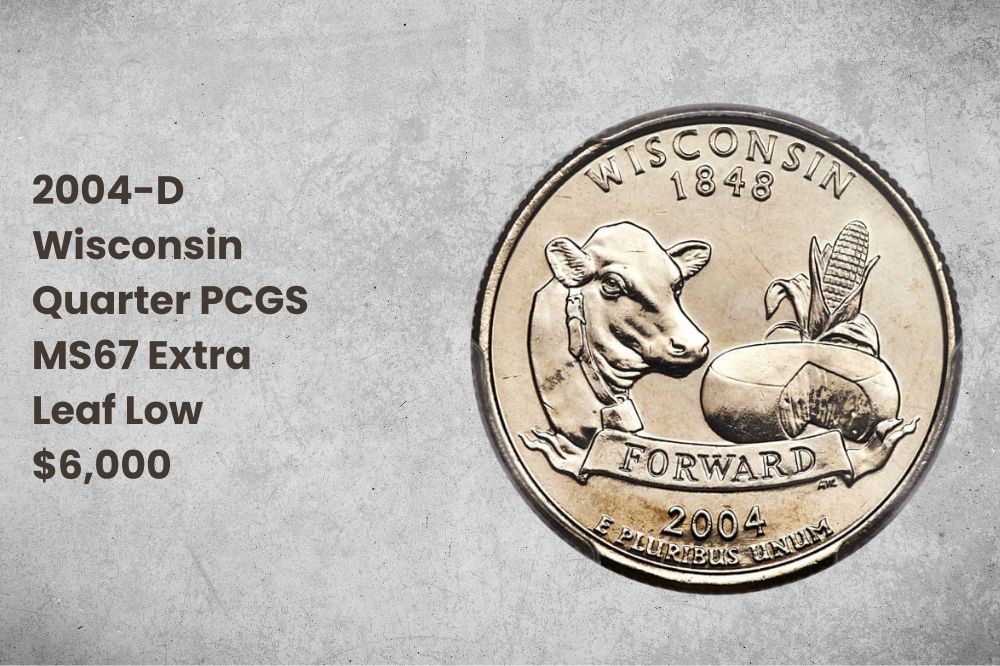
The pair to the extra leaf high is – you’ve guessed it – the extra leaf low! This one was also minted in Denver in 2004. But in this case, the rounded tool was positioned differently. As a result, the additional leaf appears low down on the husk of corn.
Just as with the high leaf version, there’s some debate over whether this qualifies as a true error coin. But in any case, it’s rare to find it in excellent condition.
This example was graded MS67 by the PCGS, the Professional Coin Grading Service. That makes it pretty much top of the tree. Only four coins of this type and quality are known to exist, with none finer.
It came up for auction in January 2020. The low leaf version is slightly less rare than the high leaf one. Nevertheless, this coin’s remarkable condition set it apart from the crowd. When the hammer fell, it achieved a price of $6,000.
6. 2009-D District of Columbia Quarter PCGS MS66 Double Die DDR FS-801 $3,000
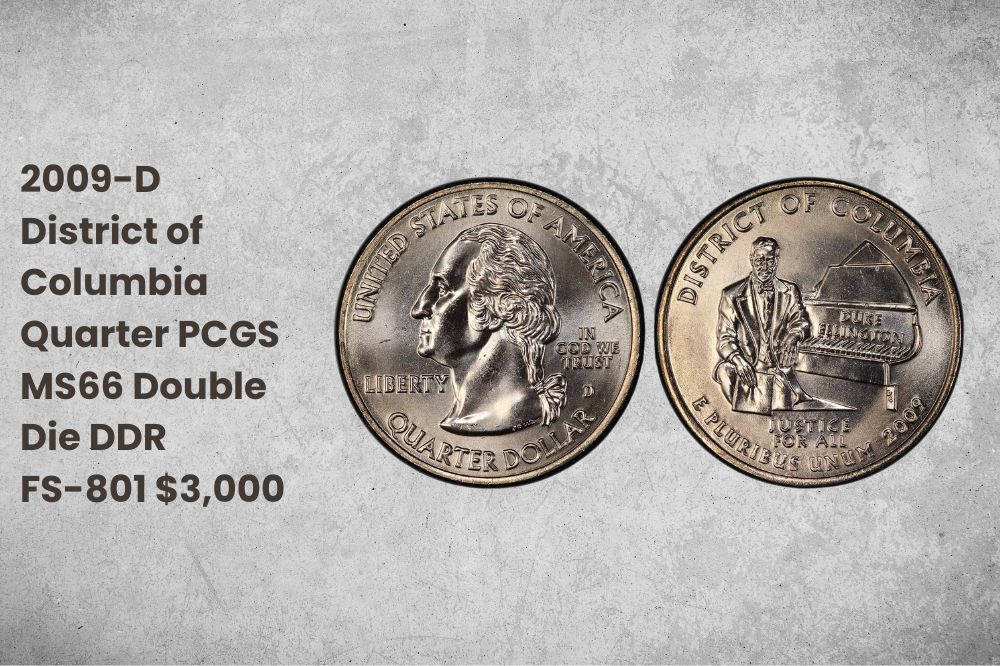
The District of Columbia was one of six territories added late to the 50 states series of quarters. And amongst the coins produced were some that had a notable error.
The error showed on the obverse side, which showed Duke Ellington. It was a double die, and careful inspection showed prominent doubling in the “ELL” of his name. Double lines could also be seen on his sleeve, and on some of the piano keys.
Only around a dozen of these coins are known to exist, and prices vary widely, depending on quality. A specimen graded MS66, like this one, can be bought today for around $3,000.
7. 1999-P Connecticut Quarter Struck on the End of a Feeder Finger, NGC MS66 $3,720
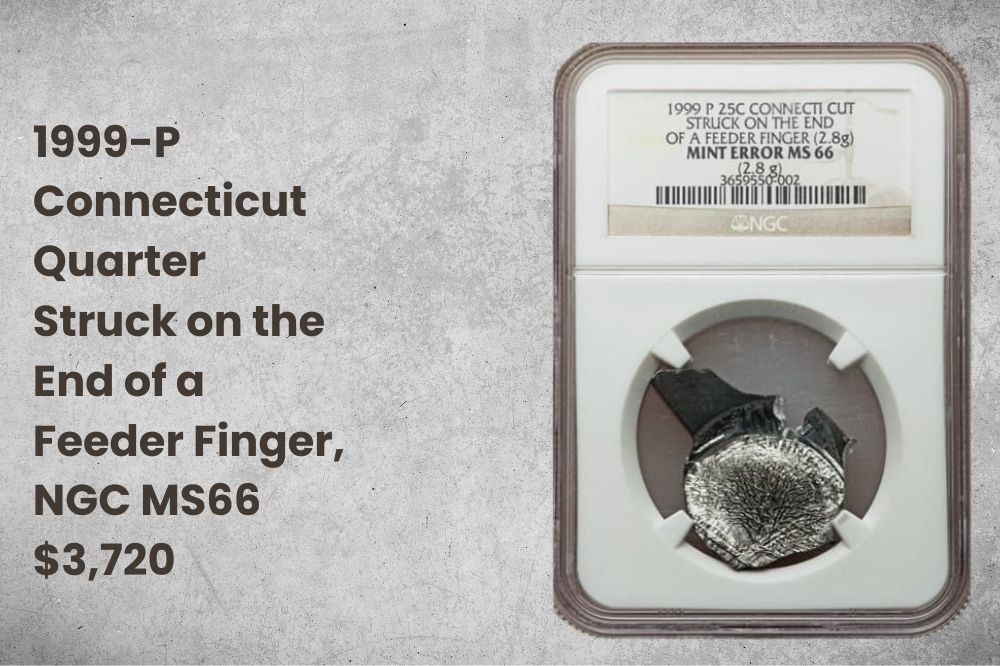
At first glance, you wouldn’t imagine this to be a valuable coin. Not to put too fine a point on it, it looks a bit of a mess!
As coins are being made, feeder fingers push the planchets into place to be struck by the dies. But sometimes the fingers malfunction, getting jammed. That’s what happened here. As a result, the quarter was struck on the feeder finger itself.
This is a rare error, so specimens like these are very collectable. This one, minted in 1999, came up for auction in January 2020. The winning bid was $3,720, including the buyer’s premium.
8. 2002-P Indiana Quarter Struck on Dime Planchet, PGCS MS64 $4,025
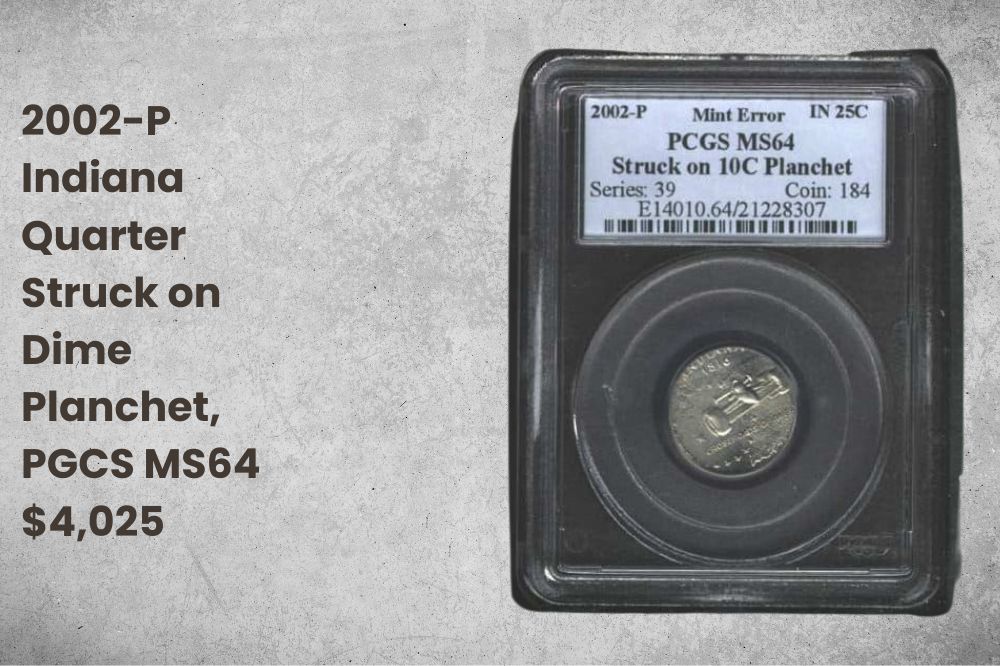
This quarter, commemorating the statehood of Indiana, was minted in Philadelphia in 2002. But one look shows you something went wrong. Instead of being struck on the correct sized planchet, it was struck on one for a dime.
As a result, the image is incomplete. Although it’s centered pretty much as it should be, the edges are missing. It should have been identified and disposed of before it left the mint – but somehow it escaped.
It was offered for sale in November 2002. And when the auctioneer’s hammer fell, it made over $4,000.
9. 1999-P Susan B. Anthony Dollar Struck on Georgia Quarter, PCGS MS64 $6,325
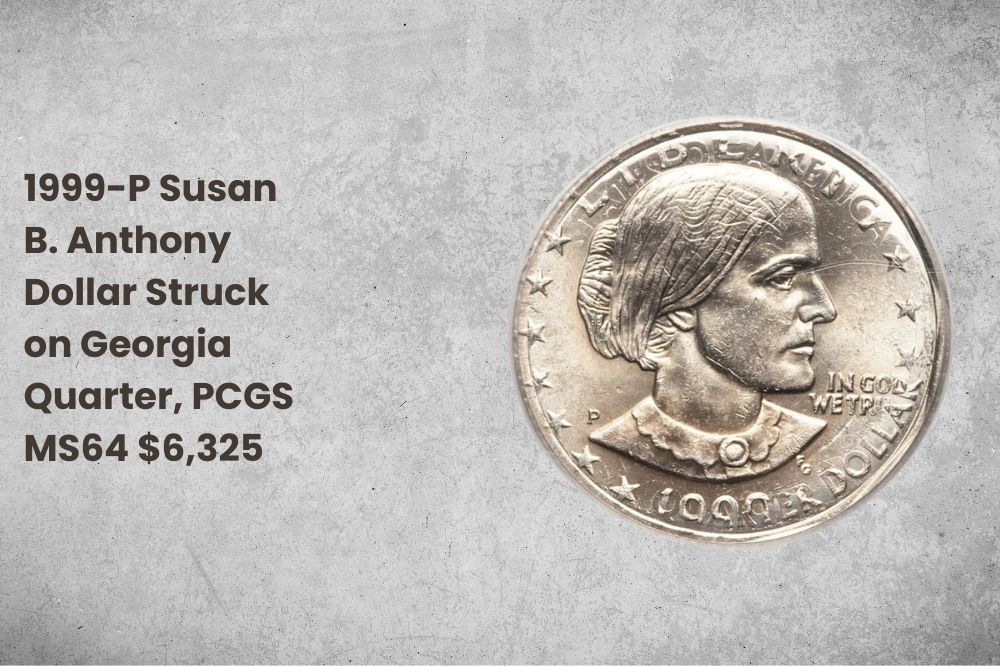
This is what’s known as a “double denomination coin”. Instead of a blank planchet being used for this 1999 dollar, it was struck on a Georgia quarter.
Details from both the quarter and the dollar are clearly visible. And collectors of state quarters will be pleased that these include the word “Georgia” from the former.
It was certified MS64 by the PCGS. And when it was presented at auction in January 2012, it sold for $6,325.
10. 2000-P Maryland Quarter Struck on Clad Dime Planchet, PCGS MS64 $6,325
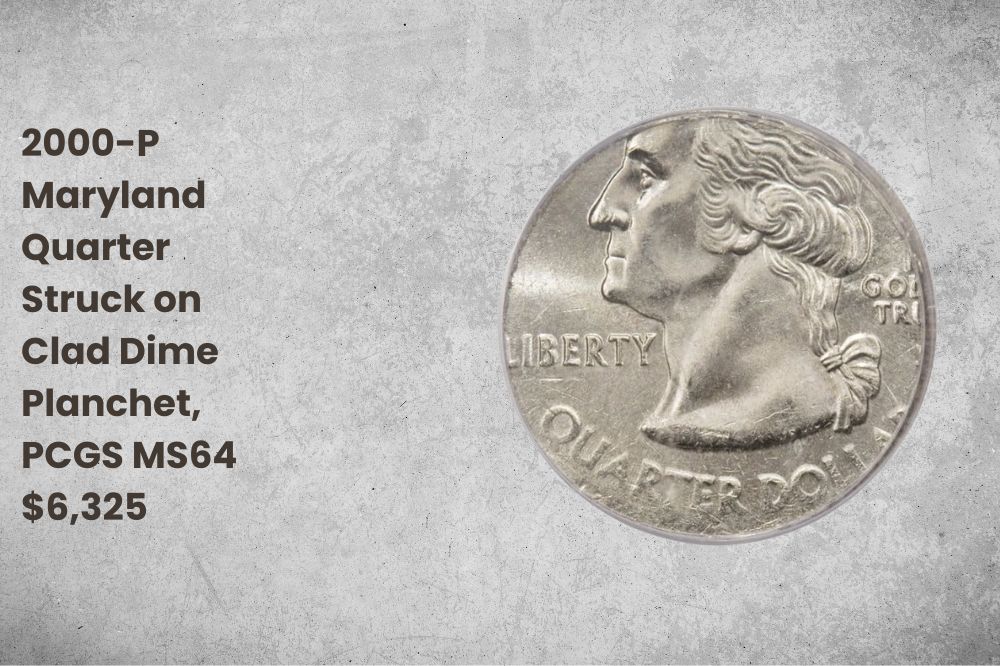
The obverse of this coin shows George Washington almost bursting out of the edges. The strange effect is because it was struck on a much smaller planchet than it should have been. Rather than one for a quarter, a dime planchet somehow found its way into the machine.
The mint’s quality assurance practices should easily have picked up this coin – but somehow they missed it. It was graded MS64 by the PCGS, and was a rare find for collectors.
It sold at auction in September 2007, making $6,325.
11. 2006-P North Dakota Quarter Struck on Steel Washer, PCGS MS62 $8,625
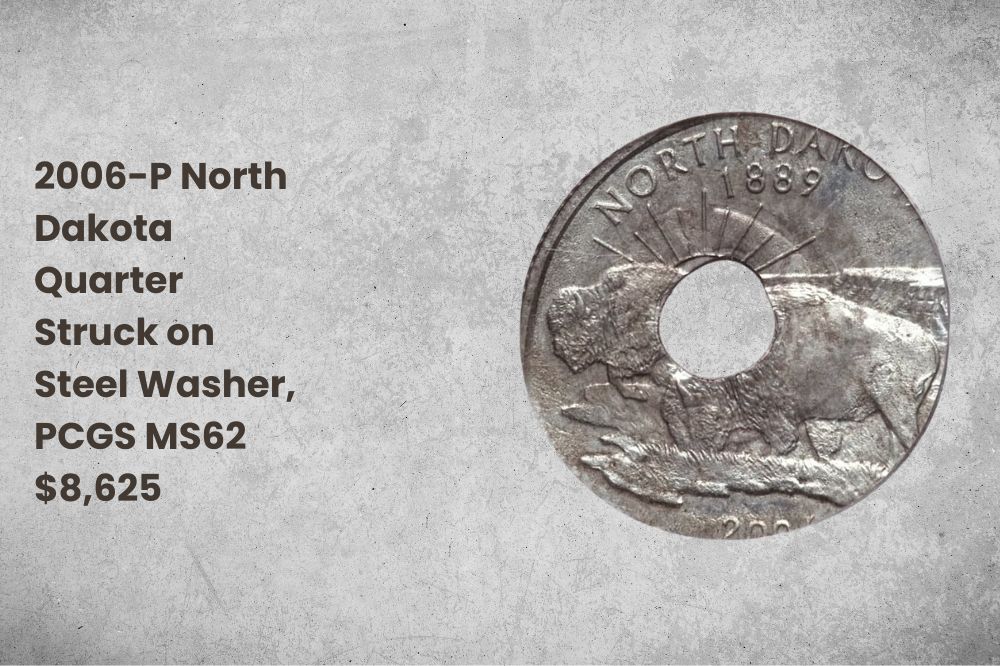
This North Dakota quarter at first glance looks like a foreign coin. That’s because it has a big hole in the middle.
The reason? Instead of being struck on a planchet – a solid disc – it was struck on a steel washer!
Whether this was accidental or the result of a deliberate act by a mint worker, it’s impossible to say. But however it came about, it was astonishing that it wasn’t found and destroyed. This coin would have been easy to single out: unlike “proper” quarters, it’s magnetic.
Yet somehow, it survived. It was graded a relatively lowly MS62 by the PCGS. But when it came to auction in August 2011, it sold for $8,625.
12. 1999-P New Jersey Quarter on Foreign Planchet, NGC MS65 $13,200
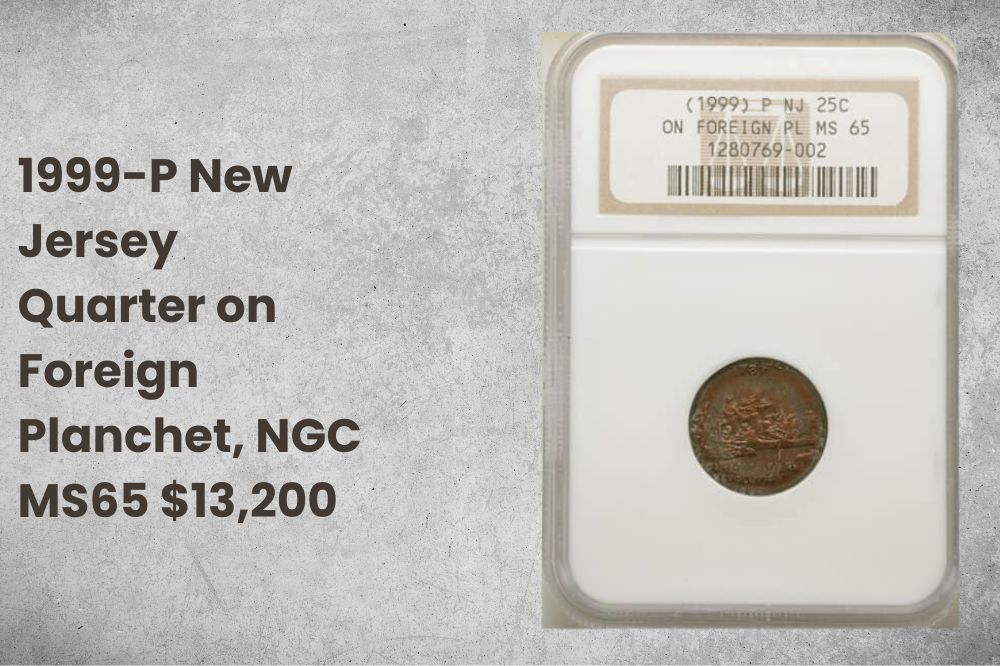
Sometimes coins are struck on planchets that were never intended for that use. So it was with this New Jersey Statehood quarter, minted in Philadelphia in 1999. This was struck on a planchet intended for use in another country.
It was assessed by the NGC, and graded as MS65. And its rarity meant that it got collectors hot under the collar when it came to auction in April 2021.
An internet bidder paid $13,200, including the buyer’s premium, to add it to their collection.
13. 2000-P Lincoln Cent Struck onto New Hampshire Quarter, PCGS MS65 $13,200
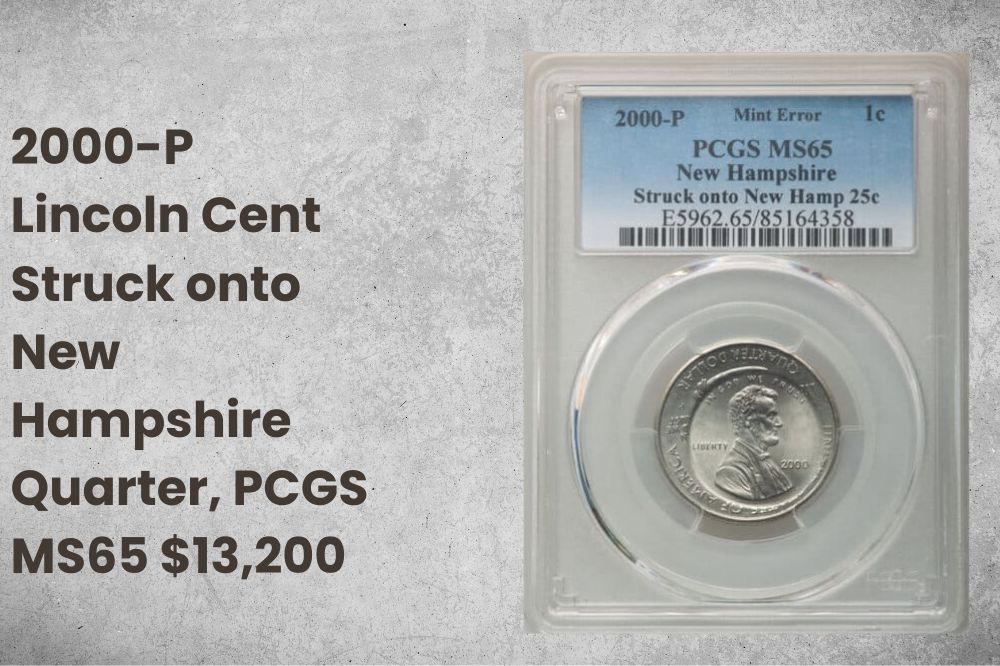
Sometimes, one coin is struck onto a completely different one. That’s what happened with this Lincoln cent. It finds its way onto our list because it was struck on a New Hampshire Quarter.
The cent imprint is at 180 degrees to the original quarter. As a result, it’s still possible to see a faint outline of Washington’s portrait, together with the original Philadelphia mint mark.
Both the quarter and the cent were struck in Philadelphia in 2000. How the error occurred is unknown, but it’s a rare thing. When it came to auction, it sold for $13,200.
14. 1983-P Washington Quarter Overstruck on an Amusement Token NGC MS65 $15,863
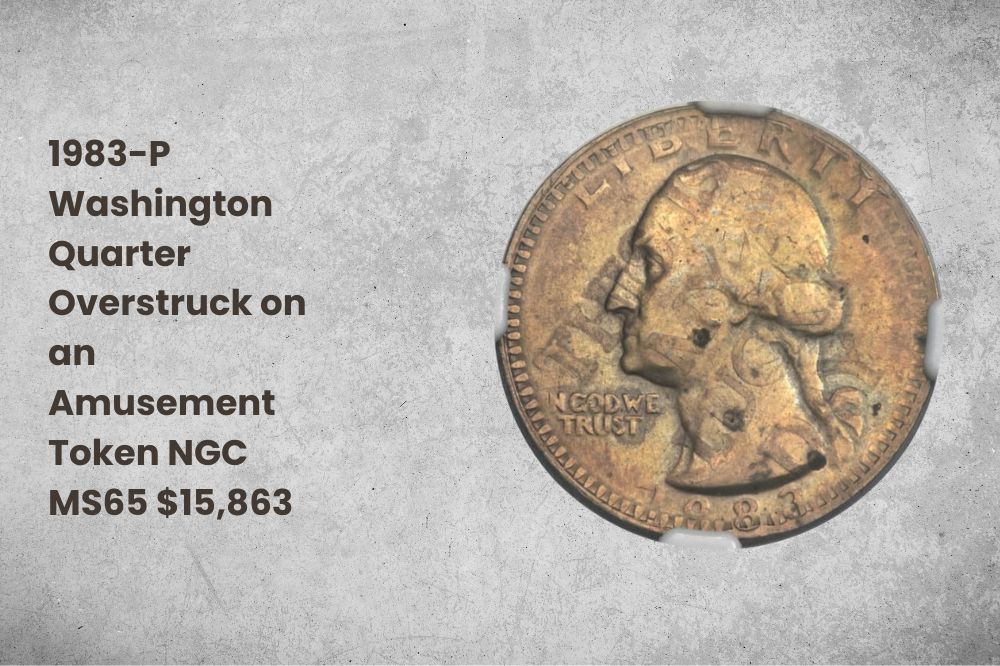
It’s hard to imagine that this bizarre 1983 coin was really the result of an error. Instead, it seems more likely that a mischievous mint worker fed an amusement token into the machine.
The result – which the individual concerned would have had little chance of ever recovering – was highly collectable. You can still read the words on the original token – “This is my lucky day”. And it certainly was lucky for the person who found it!
It came to auction in July 2014. By then, the NGC had graded it MS65. It sold for an impressive $15,863, including the 15 per cent buyer’s premium.
15. (2000-P) Sacagawea Dollar with 50 State Quarter Mule $100,000 – $200,000
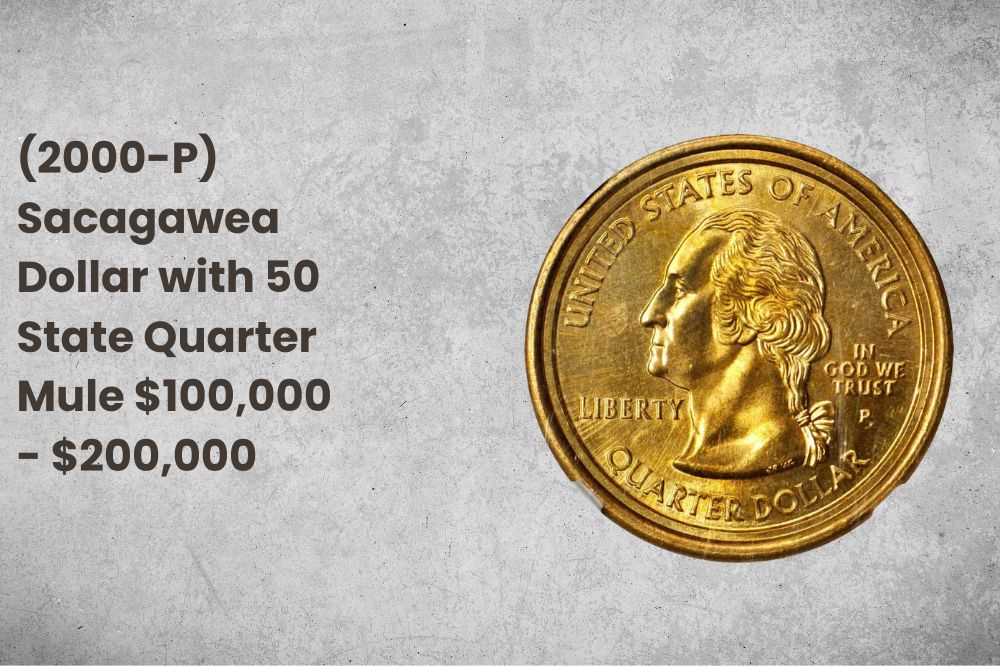
No list of State quarter errors would be complete without what’s known as a “mule”. These are the rarest types of mint errors.
They’re formed using dies that were never intended to be used in the same coin. That could involve any of the dies used in coin production – for the obverse or reverse sides, or for the collar.
The most famous of all mules is the pairing of a Sacagawea dollar with a 50 State quarter. The first example came to light in 2000, and since then, two further error die pairings have been discovered.
Various theories have been put forward to explain how the errors were made, but no-one knows for sure.
Only 19 examples are known to exist. One specimen, graded MS67 by the PCGS, achieved a price of $192,000 when it came to auction in 2018.
A Costly Mistake
That brings us to the end of our look at the 15 most valuable state quarter errors sold in recent years. We hope you’ve enjoyed learning more about these fascinating coins. And perhaps you’ve got your own ideas about the circumstances that led to their creation!
As these coins show, sometimes a mistake can create something new that’s rare and precious. So if you’ve got a state quarter that looks a bit unusual, take a closer look. It might just be worth some serious money!
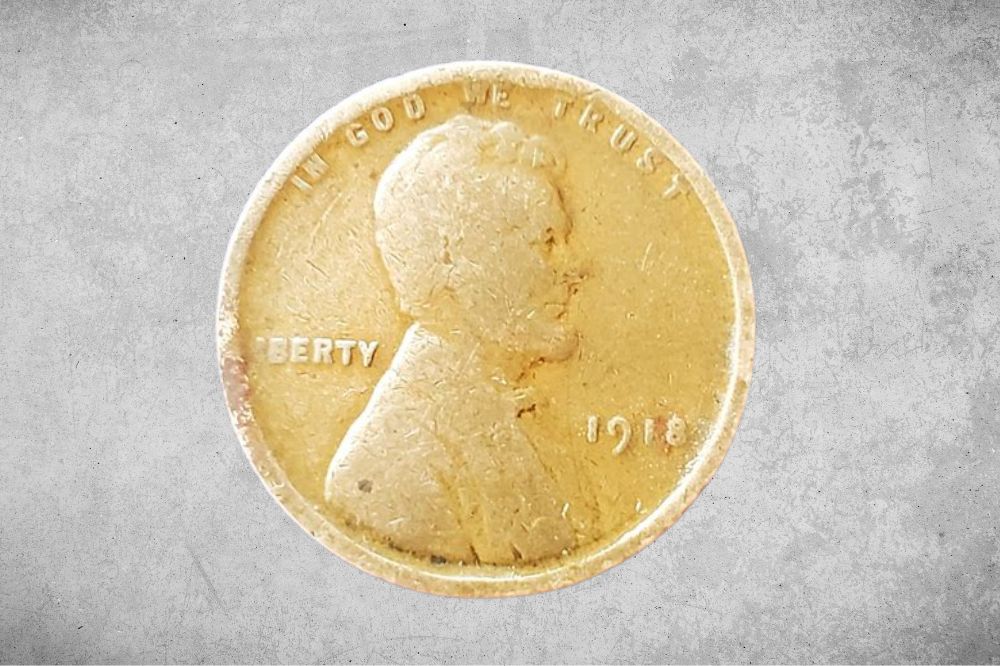
I just found a barely stamped 2015 quarter super light barely see the center print but you can make out the year the front is clearly not been pressed all the way either.
Who can I send pics too?
I have a 2000 United States .25 with one side
Silver colour the other gold colour! Have u ever seen one before?
Thank you very much for sharing that information. I just wanted to let you know I have been collecting change for a while. I have not sold anything that I have. I just keep on writing down the dates and what’s wrong with it.
Eye inside of P mint mark, how do I post pictures?
Just wondering I have a state quarter were at the nacked eye you can’t see a date or a mint mark but held in the right light you can and the lettering is all messed up but the back is blank is it worth anything
I have one also, front is fine but the back is a complete blank. Really like to know who to send pictures to
I have a 1974 Quarter without a mint mark. It has been circulated. Is it valuable?
I have a 1999 Connecticut quarter that the rim looks wavy like it flat but then looks two toned like bight, dull, bright, dull, bright, dull etc… all the way around is it valuable
I have a 2013 New Hampshire State Quarter that has no completely visible information around the reverse side of the coin. The center of the coin has the scene of White Mountain but no other information is visible. There are marks that indicate information should be there but it is very bleak and vacant. It does not appear to have been filed off so I don’t know if this is an error coin or if someone destroyed its real appearance. Any help is appreciated.
I have found a Washington quarter that looks like a grinding has benn done to back but the front feels wrong as in a mis cast or some type of error and donr know where to go to find the value or if its a fake that’s been made by a person inquiries are welcome
I have a 2014 P mint mark, Colorado Great Sand Dunes and on the reverse side at the bottom of every letter and number near the rim is looks stretched with scratches and again just at the bottom of the letters and numbers. Id say double die but I can’t even say that. It’s 3dish with scratches. I’ve never seen anything like it. Has anyone seen this?
I have a 2021 Tuskegee quarter that the highest level details are blank it’s in amazing condition it just doesn’t have some details. Dose not look like it’s worn I think it’s an error. Not sure though
I have a 2023 quarter that is missing Washington’s nose and on other side it’s messed up as well who do I need to talk to?
I have a 2000 South Carolina quarter that you can’t see the state, year, and other things wrong with this quarter on both front and back
I have a 2005P Oregon quarter with no visable copper and I have not been able to find any information on it, do you have any ideas of its value?
I have a quarter that is only stamped 19 for the year …can anyone please tell me if it’s worth anything
I have a 2006 south dakota quarter with a gray front and a brownish red on the reverse side. It a D mint mark . Anyone one what going on with it. ?
I have one also, front is fine but the back is a complete blank. Really like to know who to send pictures to
I have a 2017 Ellis Island quarter that looks solid copper anyone know about this
I have a 2001 Vermont quarter with two P mint marks, one where it’s supposed to be and the other turned 1/8 is below it. Surface holes are present on both sides of the coin.